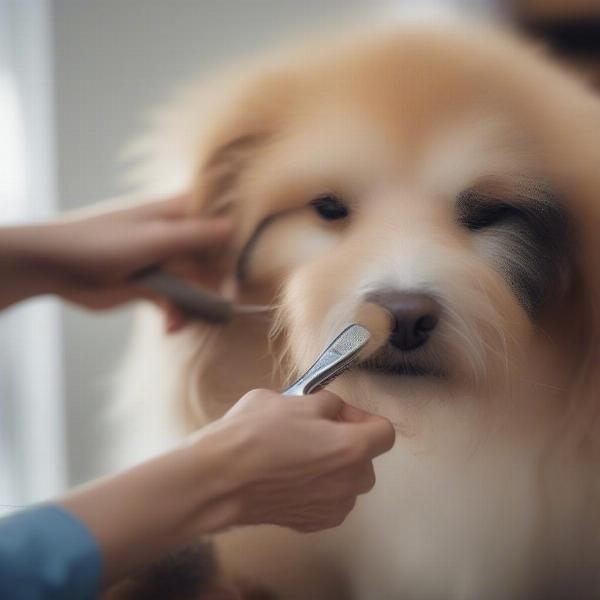Dry skin is a common problem for dogs, and it can be uncomfortable and even painful for them. If your dog is constantly scratching, licking, or biting at their skin, they might be suffering from dry skin. This can lead to further complications like infections and hair loss if left untreated. How do you address this issue and ensure your furry friend’s comfort? This article explores the causes, symptoms, and solutions for canine dry skin.
Understanding the Causes of Dry Skin in Dogs
Just like humans, dogs can experience dry skin due to a variety of reasons. These include environmental factors like low humidity, especially during winter months, and frequent bathing with harsh shampoos. Allergies, both environmental and food-related, can also manifest as dry, itchy skin. Underlying health issues, such as hypothyroidism and parasites, can also contribute to dry skin. Finally, nutritional deficiencies, particularly a lack of essential fatty acids, can play a significant role.
Recognizing the Signs of Dry Skin
Dry skin in dogs can present in several ways. The most common sign is excessive scratching, often accompanied by licking and biting at the affected areas. You might notice flaky or scaly skin, redness, and even hair loss in severe cases. Dandruff is another common indicator. If you observe any of these symptoms, it’s essential to address the issue promptly to prevent further complications.
Effective Solutions for Dry Skin
Addressing your dog’s dry skin starts with identifying the underlying cause. If you suspect allergies, a vet visit is crucial to determine the specific allergen and develop a management plan. For environmentally-caused dry skin, adding a humidifier to your home can make a significant difference. Using a dog-specific shampoo with moisturizing properties, and reducing bathing frequency, can also help.
Nutritional Support for Healthy Skin
A balanced diet plays a vital role in maintaining healthy skin and coat. Ensure your dog’s food contains sufficient essential fatty acids, particularly omega-3 and omega-6. Supplements, like fish oil or flaxseed oil, can be beneficial, but always consult your vet before adding them to your dog’s diet. They can recommend the correct dosage based on your dog’s breed, size, and overall health.
Grooming Practices for Dry Skin Management
Regular brushing helps distribute natural oils, keeping your dog’s coat healthy and reducing dryness. Choose a brush appropriate for your dog’s coat type. Avoid over-bathing, as it strips away essential oils. When you do bathe your dog, use lukewarm water and a gentle, moisturizing shampoo formulated for dogs.
 Dog getting brushed to manage dry skin
Dog getting brushed to manage dry skin
When to Seek Veterinary Advice
While many cases of dry skin can be managed at home, it’s important to seek professional advice if the condition persists or worsens. If your dog’s scratching is excessive, leading to open sores or infections, a vet visit is necessary. Your vet can diagnose the underlying cause and prescribe appropriate treatment, which may include medicated shampoos, topical creams, or oral medications.
Conclusion
Dry skin can be a significant source of discomfort for your furry friend. By understanding the causes, recognizing the symptoms, and implementing the solutions outlined above, you can help your dog achieve healthy, hydrated skin and a shiny, comfortable coat. Don’t hesitate to contact your veterinarian if you have any concerns – addressing dry skin promptly is key to ensuring your dog’s overall well-being.
FAQ
- How often should I bathe my dog with dry skin? Generally, bathing every 4-8 weeks is sufficient for dogs with dry skin. However, your vet can recommend a specific bathing schedule based on your dog’s individual needs.
- Can I use human moisturizer on my dog? No, human moisturizers may contain ingredients that are toxic to dogs. Always use products specifically formulated for canine use.
- What are the best dog foods for dry skin? Look for dog foods rich in omega-3 and omega-6 fatty acids, and avoid foods with artificial colors, flavors, and preservatives.
- Is dry skin a sign of a serious health problem? While dry skin itself isn’t usually a serious issue, it can be a symptom of underlying health conditions. Consult your vet for a proper diagnosis.
- How can I tell if my dog’s dry skin is caused by allergies? Allergy-related dry skin is often accompanied by other symptoms like excessive itching, redness, and inflammation. Allergy testing can confirm the allergen.
- Are there any home remedies for dog dry skin? Oatmeal baths and coconut oil can be soothing for dry skin, but always consult your vet before trying home remedies.
- How long does it take for dry skin to improve in dogs? With proper treatment and management, you should see improvement within a few weeks.
ILM Dog is a leading online resource dedicated to providing dog owners with reliable information on dog care, breeds, health, training, nutrition, grooming, and much more. We aim to empower dog owners with the knowledge and resources they need to provide the best possible care for their canine companions. We cover a range of topics, from choosing the right breed to dealing with specific health concerns like dry skin. For expert advice and more valuable insights into dog care, contact us via email at [email protected] or phone at +44 20-3965-8624. Visit ILM Dog for all your dog-related needs.